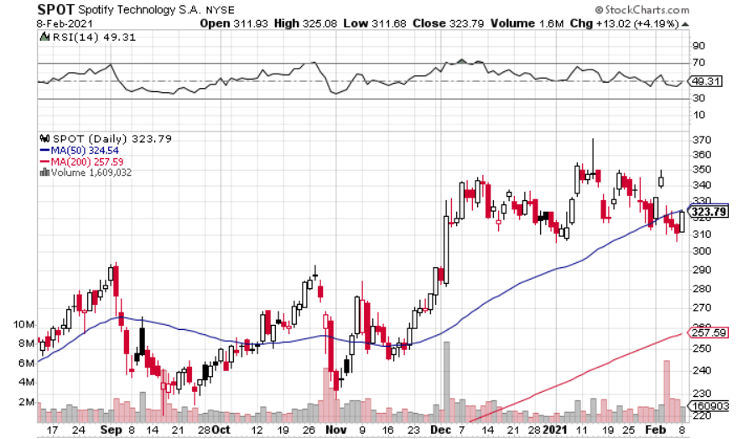Why You Should Buy the Post-Earnings Dip on Spotify Sure, shares are down 6 percent, but the Spotify growth story isn't anywhere close to ending.
By Nick Vasco
This story originally appeared on MarketBeat

Spotify (NYSE: SPOT) reported its year-end earnings last week, and grew its user base faster than the average expectations. Paid subs increased 24% yoy to 155 million, while guidance called for 150-154 million. Monthly active users (MAUs) were up 27% yoy to 345 million, at the top of the 340-345 million that was previously estimated.
Shares, however, are down more than 6% since the release. The culprit was 2021 guidance – the company expects paid subs to be 172-184 million and MAUs to be 407-427 million at the end of 2021. The midpoints of those ranges would work out to growth rates of 15% and 21%, respectively. Most companies would be thrilled with that kind of growth, but it's not good enough for a company that needs to keep growing to cover its high content costs.
But the Spotify growth story isn't anywhere close to ending. When we consider the context of the projected deceleration, a disappointment turns into a possible buying opportunity.
On the Q4 earnings call, one of the central themes was management promising that it would only forecast numbers that it was very confident the company could reach.
CEO Daniel Ek said, "2021 brings more uncertainty than any normal year. That said, we have a high degree of confidence in our ability to deliver against the guidance we've provided. And we were able to overcome unprecedented uncertainty in 2020 and exceed almost all expectations. And I believe that we can do the same in 2021."
Ek saying that this year will bring "uncertainty" is a not-so-subtle reference to the pandemic. Nobody knows when life will get back to normal, and the pandemic has heavily impacted Spotify user growth rates. Therein lies another reason not to be concerned about the projected deceleration in growth; lockdowns likely brought users onto Spotify that otherwise wouldn't have signed up until 2021. Ek referred to a pull-forward effect on the Q4 call. We saw the same thing with Netflix (NASDAQ: NFLX) last year.
If not for the pandemic, Spotify user growth likely would have been a little lower in 2020 and forecasted to be a little higher in 2021. There may have been no forecasted deceleration. Some investors, however, are making a mistake by treating this as a normal deceleration. Spotify growth is more likely to accelerate in 2022 than decelerate or stay the same.
Spotify sees a multi-billion user opportunity and it's hard to argue with them. Anybody with an internet connection is a potential user, and Spotify, in spite of the growing competition, remains the top dog in the audio streaming industry.
What about content costs?
On its Q4 call, Spotify noted that it more than tripled the number of podcasts on its platform in 2020; from 700,000 in Q4 2019 to 2.2 million today. Some of those deals cost a pretty penny. The Joe Rogan deal, for example, is worth around $100 million. Names like Kim Kardashian West, Prince Harry, and Meghan Markle didn't come cheap.
Most of the 1.5 million new podcasts, however, cost a small fraction of the above names.
And on the Q4 earnings call, Ek disclosed that the company is going to focus more on in-house development than (expensive) acquisitions moving forward. "Most of our strategy going forward, while we don't exclude any further acquisitions, it is about ramping the ability of our own production capabilities that we now have through all the studios that we have acquired."
Spotify now has plenty of incredible content – in both music and podcasting. It can afford to take a more selective approach to acquisitions moving forward and still maintain existing users and acquire new users. Though the company is still losing money, it is trading at just 5.4x forward sales. If Spotify can grow users at a CAGR of 20% over the next 3-4 years – which is very possible – it could grow its revenues well past its expenses.
How Should You Play Spotify?

Spotify appears to have found support in the $310-320 range. Shares previously found support in the same range around the New Year.
We could end up looking back at this time as a great opportunity to get into a long-term winner.










